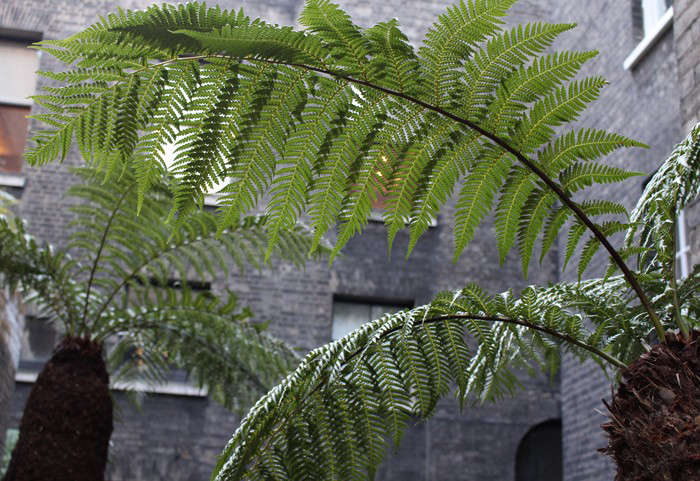Tree Fern, Dicksonia antarctica: “Wooly Tree Fern”
Long, long ago when our planet was young and a few clever fish were just beginning to think about growing legs and walking out of the ooze, even before the dinosaurs appeared, there were tree ferns. Scientists think that somewhere around 360 million years ago the earth was covered with thick, tall forests of colossal ferns and mosses. We all know the dinosaurs are gone, but those giant ferns… well, their direct descendants are still here, maybe as close as in your own backyard.
Nicknamed the “wooly” or “soft” tree fern, Dicksonia antarctica is a species with the basic shape of a child’s drawing of a tree: straight, sturdy, wide brown trunk with a big burst of green on top. In this case the green consists of a delicate crown of feathery arching fronds from 3 to 6 feet long.
Above: Photograph by Richard Bryant/Arcaid. For more of this garden, see A Secret Courtyard Garden in Piccadilly, Ancient Tree Ferns Included.
It looks like a giant fern lifted high above the ground by its very own trunk/plant stand. In the wild it is most often found in moist areas in rain forests, along creek beds and sometimes in cloud forests. It can grow as tall as 20 feet or even more but is extremely slow growing and usually doesn’t go above 15 feet in cultivation.
Above: Photograph by Ruth Hartnup via Flickr.
Cheat Sheet
- The tree fern provides a strong tropical statement in any garden, whether growing in the ground amidst other ferns for a jungle feel or in a pot on a patio amid brightly colored cannas, heliconias, and caladiums.
- In the forest, air plants, like Tillandsia, as well as orchids, small ferns, and mosses grow on the trunks of tree ferns so you might want to add some to your own plant to add interest and evoke a Jurassic Park atmosphere.
- Tree ferns do not need pruning to maintain their classic shape; just remove any damaged or yellowing fronds.
Keep It Alive
- Tree ferns prefer a sheltered, shady spot protected from the wind and need plenty of water in hot weather.
- When watering be sure to include the trunk, which is made up of aerial roots surrounding a narrow stem and needs as much moisture as the conventional underground roots.
- Dicksonia antarctica is hardy in zones 9 to 11 and, especially young specimens under 4 feet tall must be protected during freezing weather, either by moving them indoors or by wrapping in landscape cloth or burlap.
Above: Photograph by Kendra Wilson.
The most vulnerable part of the tree fern is the growing tip of its crown, which should never be watered (which can lead to rot) or allowed to freeze. If you are growing your tree fern outdoors and freezing weather is forecast, you can protect the crown by adding a layer of compacted straw on top of it to shield the plant while also allowing it to breathe.
Above: Photograph by Matthew Williams for Gardenista. For more of our editor Christine Chang Hanway’s garden, see Urban Space: Getting My London Garden to Love Me Back.
In its native Australia the tree fern population has been on the decline since the early 19th century due to habitat destruction and over-zealous collection by plant sellers. If you decide to add the dramatic beauty of a tree fern to your garden, be sure to buy it from a reputable nursery to ensure that your plant has been acquired responsibly.
For more ideas about how to use tree ferns in a landscape, see:
- Landscape Architect Visit: A Modern Makeover for a San Francisco Grande Dame, by Scott Lewis.
- 10 Garden Ideas to Steal from London.
- Garden Visit: A Fern-Filled Forest in Australia.
Finally, get more ideas on how to successfully plant, grow, and care for tree fern with our Tree Fern: A Field Guide.
Interested in other tropical plants for your garden or indoor space? Get more ideas on how to plant, grow, and care for various tropical plants with our Tropical Plants: A Field Guide.
















Have a Question or Comment About This Post?
Join the conversation (0)